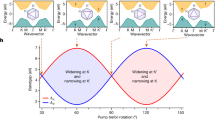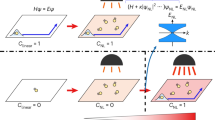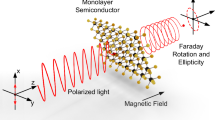Abstract
Reflection and refraction of waves occur at the interface between two different media. These two fundamental interfacial wave phenomena form the basis of fabricating various wave components, such as optical lenses. Classical refraction—now referred to as positive refraction—causes the transmitted wave to appear on the opposite side of the interface normal compared to the incident wave. By contrast, negative refraction results in the transmitted wave emerging on the same side of the interface normal. It has been observed in artificial materials1,2,3,4,5, following its theoretical prediction6, and has stimulated many applications including super-resolution imaging7. In general, reflection is inevitable during the refraction process, but this is often undesirable in designing wave functional devices. Here we report negative refraction of topological surface waves hosted by a Weyl phononic crystal—an acoustic analogue of the recently discovered Weyl semimetals8,9,10,11,12. The interfaces at which this topological negative refraction occurs are one-dimensional edges separating different facets of the crystal. By tailoring the surface terminations of the Weyl phononic crystal, constant-frequency contours of surface acoustic waves can be designed to produce negative refraction at certain interfaces, while positive refraction is realized at different interfaces within the same sample. In contrast to the more familiar behaviour of waves at interfaces, unwanted reflection can be prevented in our crystal, owing to the open nature of the constant-frequency contours, which is a hallmark of the topologically protected surface states in Weyl crystals8,9,10,11,12.
This is a preview of subscription content, access via your institution
Access options
Access Nature and 54 other Nature Portfolio journals
Get Nature+, our best-value online-access subscription
$29.99 / 30 days
cancel any time
Subscribe to this journal
Receive 51 print issues and online access
$199.00 per year
only $3.90 per issue
Buy this article
- Purchase on Springer Link
- Instant access to full article PDF
Prices may be subject to local taxes which are calculated during checkout



Similar content being viewed by others
References
Shelby, R. A., Smith, D. R. & Schultz, S. Experimental verification of a negative index of refraction. Science 292, 77–79 (2001).
Cubukcu, E., Aydin, K., Ozbay, E., Foteinopoulou, S. & Soukoulis, C. M. Negative refraction by photonic crystals. Nature 423, 604–605 (2003).
Yao, J. et al. Optical negative refraction in bulk metamaterials of nanowires. Science 321, 930 (2008).
Yang, S. et al. Focusing of sound in a 3D phononic crystal. Phys. Rev. Lett. 93, 024301 (2004).
Zhang, S., Yin, L. & Fang, N. Focusing ultrasound with an acoustic metamaterial network. Phys. Rev. Lett. 102, 194301 (2009).
Veselago, V. G. The electrodynamics of substances with simultaneously negative values of ε and μ. Sov. Phys. Usp. 10, 509 (1968).
Pendry, J. B. Negative refraction makes a perfect lens. Phys. Rev. Lett. 85, 3966–3969 (2000).
Wan, X., Turner, A. M., Vishwanath, A. & Savrasov, S. Y. Topological semimetal and Fermi-arc surface states in the electronic structure of pyrochlore iridates. Phys. Rev. B 83, 205101 (2011).
Burkov, A. A. & Balents, L. Weyl semimetal in a topological insulator multilayer. Phys. Rev. Lett. 107, 127205 (2011).
Xu, S.-Y. et al. Discovery of a Weyl fermion semimetal and topological Fermi arcs. Science 349, 613–617 (2015).
Lv, B. Q. et al. Experimental discovery of Weyl semimetal TaAs. Phys. Rev. X 5, 031013 (2015).
Soluyanov, A. A. et al. Type-II Weyl semimetals. Nature 527, 495–498 (2015).
Hasan, M. Z. & Kane, C. L. Topological insulators. Rev. Mod. Phys. 82, 3045–3067 (2010).
Qi, X.-L. & Zhang, S.-C. Topological insulators and superconductors. Rev. Mod. Phys. 83, 1057–1110 (2011).
Xu, G., Weng, H., Wang, Z., Dai, X. & Fang, Z. Chern semimetal and the quantized anomalous hall effect in HgCr2Se4. Phys. Rev. Lett. 107, 186806 (2011).
Huang, X. et al. Observation of the chiral-anomaly-induced negative magnetoresistance in 3D Weyl semimetal TaAs. Phys. Rev. X 5, 031023 (2015).
Lu, L., Fu, L., Joannopoulos, J. D. & Soljacic, M. Weyl points and line nodes in gyroid photonic crystals. Nat. Photon. 7, 294–299 (2013).
Lu, L. et al. Experimental observation of Weyl points. Science 349, 622–624 (2015).
Chen, W. J., Xiao, M. & Chan, C. T. Photonic crystals possessing multiple Weyl points and the experimental observation of robust surface states. Nat. Commun. 7, 13038 (2016).
Noh, J. et al. Experimental observation of optical Weyl points and Fermi arc-like surface states. Nat. Phys. 13, 611–617 (2017).
Yang, B. et al. Direct observation of topological surface-state arcs in photonic metamaterials. Nat. Commun. 8, 97 (2017).
Chang, M. L., Xiao, M., Chen, W. J. & Chan, C. T. Multiple Weyl points and the sign change of their topological charges in woodpile photonic crystals. Phys. Rev. B 95, 125136 (2017).
Xiao, M., Chen, W. J., He, W. Y. & Chan, C. T. Synthetic gauge flux and Weyl points in acoustic systems. Nat. Phys. 11, 920–924 (2015).
Yang, Z. & Zhang, B. Acoustic type-II Weyl nodes from stacking dimerized chains. Phys. Rev. Lett. 117, 224301 (2016).
Li, F., Huang, X., Lu, J., Ma, J. & Liu, Z. Weyl points and Fermi arcs in a chiral phononic crystal. Nat. Phys. 14, 30–34 (2018).
Wang, Z., Chong, Y., Joannopoulos, J. D. & Soljacic, M. Observation of unidirectional backscattering-immune topological electromagnetic states. Nature 461, 772–775 (2009).
Rechtsman, M. C. et al. Photonic floquet topological insulators. Nature 496, 196–200 (2013).
Susstrunk, R. & Huber, S. D. Observation of phononic helical edge states in a mechanical topological insulator. Science 349, 47–50 (2015).
Lu, J. et al. Observation of topological valley transport of sound in sonic crystals. Nat. Phys. 13, 369–374 (2017).
Gao, F. et al. Topologically protected refraction of robust kink states in valley photonic crystals. Nat. Phys. 14, 140–144 (2018).
Notomi, M. Theory of light propagation in strongly modulated photonic crystals: refractionlike behavior in the vicinity of the photonic band gap. Phys. Rev. B 62, 10696–10705 (2000).
Fang, C., Gilbert, M. J., Dai, X. & Bernevig, B. A. Multi-Weyl topological semimetals stabilized by point group symmetry. Phys. Rev. Lett. 108, 266802 (2012).
de Juan, F., Grushin, A. G., Morimoto, T. & Moore, J. E. Quantized circular photogalvanic effect in Weyl semimetals. Nat. Commun. 8, 15995 (2017).
Hirayama, M., Okugawa, R., Ishibashi, S., Murakami, S. & Miyake, T. Weyl node and spin texture in trigonal tellurium and selenium. Phys. Rev. Lett. 114, 206401 (2015).
Chang, G. et al. Universal topological electronic properties of nonmagnetic chiral crystals. Preprint at https://arXiv.org/abs/1611.07925 (2018).
Chang, G. et al. Unconventional chiral fermions and large topological Fermi arcs in RhSi. Phys. Rev. Lett. 119, 206401 (2017).
Huang, S. et al. New type of Weyl semimetal with quadratic double Weyl fermions. Proc. Natl Acad. Sci. USA 113, 1180–1185 (2016).
Acknowledgements
We thank M. Xiao for discussions. This work is supported by the National Basic Research Program of China (grant number 2015CB755500), the National Natural Science Foundation of China (grant numbers 11774275, 11674250, 11534013 and 11747310) and the Natural Science Foundation of Hubei Province (grant number 2017CFA042). F.Z. was supported by UT Dallas research enhancement funds.
Reviewer information
Nature thanks A. Grushin, B. Zhang and the other anonymous reviewer(s) for their contribution to the peer review of this work.
Author information
Authors and Affiliations
Contributions
C.Q. and Z.L. conceived the idea and supervised the project. H.H. performed the simulations. H.H., L.Y., X.F. and M.K. carried out the experiments. C.Q., H.H., X.C., F.Z. and Z.L. analysed the data and wrote the manuscript. All authors contributed to scientific discussions of the manuscript.
Corresponding authors
Ethics declarations
Competing interests
The authors declare no competing interests.
Additional information
Publisher’s note: Springer Nature remains neutral with regard to jurisdictional claims in published maps and institutional affiliations.
Extended data figures and tables
Extended Data Fig. 1 Simulated surface band dispersions in a wide frequency range.
a–c, The data are evaluated at kz = 0.5π/h for the three side surfaces XZ1, YZ1 and XZ2, respectively, the terminations of which are specified in the main text. Two gapless surface bands (green lines) traverse the two gaps between the lowest three projected bulk bands (grey regions). We focus on the lowest surface band in the main text.
Extended Data Fig. 2 Berry flux distributions, Chern numbers and bulk boundary correspondence.
a, Berry flux contributions to the lowest two bulk bands, derived from the numerically calculated Weyl charge distributions (see Fig. 2h). Here |C| labels the amplitude of the Weyl charge, and the red and black spheres indicate sources and sinks of Berry fluxes, respectively. b, Chern numbers for the lowest two bulk gaps opened at kz > 0, labelled according to the Berry flux distributions in a. (Here, the band structure is simulated at kz = 0.5π/h.) The Chern numbers Cgap of both gaps are −1, consistent with the topologically non-trivial surface spectra presented in Extended Data Fig. 1.
Extended Data Fig. 3 Different EFC properties attained by engineering the surface terminations of the Weyl phononic crystal.
a, Surface EFCs evaluated for the XZ surfaces at the Weyl frequency of 5.75 kHz, where the parameter dy defined at the top of the column characterizes the surface truncation (black dashed line). The grey regions display the projections of bulk bands, the blue spheres display the projections of the Weyl points K and K′ at 5.75 kHz, and the arrows indicate the directions of the group velocities for the surface arc states. b, Similar to a, but for the YZ surfaces specified by dx. The evolution of the EFCs for different surface terminations shows various possibilities of manipulating the surface states according to their group velocities. We focus on the cases in a2, a4 and b4 in the main text to attain the desired SAW properties. Throughout, we use 5.75 kHz to shrink the momentum regions projected by the bulk bands, which is favourable for the experimental observation of the surface arc states and the associated interfacial phenomena.
Extended Data Fig. 4 Experimental characterizations of the topologically protected SAWs.
a–c, Pressure distributions on the sample surfaces XZ1, YZ1 and XZ2 (Fig. 2d–f), respectively, scanned step by step at 5.75 kHz. The white stars indicate the positions of the point-like sound source. The propagation directions of the beams, as predicted from most of the SAWs hosted on the corresponding facets, are closely related to the positive and negative refractions observed in Fig. 3. The data are used to obtain the EFCs (with kz > 0) in Fig. 2l–n through a Fourier transform. Similar data can be collected to obtain the frequency-dependent surface band dispersions at a given kz (Fig. 2i–k). d–f, Decay signatures identified for the surface states in a–c. The data are measured along the normal directions of the sample surfaces, the in-plane coordinates of which are marked by the black circles (A–G) in a–c. The pressure magnitudes do not exhibit precise (oscillatory) exponential decay, mainly because the surface beam consists of many surface arc states with different out-of-plane decay lengths. The inset shows the kz dependence of the decay length l simulated for each surface.
Rights and permissions
About this article
Cite this article
He, H., Qiu, C., Ye, L. et al. Topological negative refraction of surface acoustic waves in a Weyl phononic crystal. Nature 560, 61–64 (2018). https://doi.org/10.1038/s41586-018-0367-9
Received:
Accepted:
Published:
Issue Date:
DOI: https://doi.org/10.1038/s41586-018-0367-9
This article is cited by
-
Surface potential-adjusted surface states in 3D topological photonic crystals
Scientific Reports (2024)
-
Topological non-reciprocal robust waveguide transport
Science China Physics, Mechanics & Astronomy (2024)
-
Mechanically-tunable bandgap closing in 2D graphene phononic crystals
npj 2D Materials and Applications (2023)
-
Bulk-local-density-of-state correspondence in topological insulators
Nature Communications (2023)
-
Strongly nonlinear topological phases of cascaded topoelectrical circuits
Frontiers of Physics (2023)
Comments
By submitting a comment you agree to abide by our Terms and Community Guidelines. If you find something abusive or that does not comply with our terms or guidelines please flag it as inappropriate.



